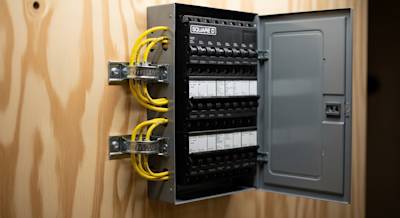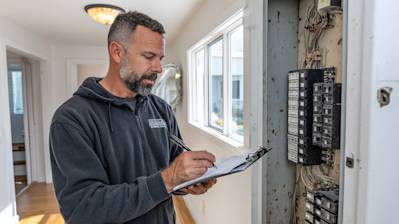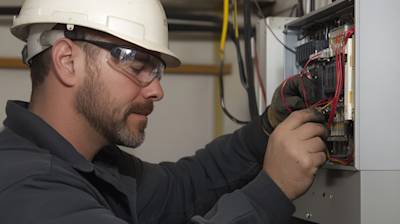Put Out Electrical Fire
In the realm of home safety, few topics are as critical as knowing how to handle electrical fires. As an experienced residential electrical contractor in Sacramento, Sagan Electric understands the unique challenges that electrical fires present. These emergencies demand swift and informed action to prevent devastating consequences. In this guide, we will walk you through the essential steps to effectively put out electrical fires while ensuring your safety and that of your loved ones.
Understanding the Nature of Electrical Fires
Electrical fires are distinct from other types of fires due to their origin and behavior. They often stem from short circuits or faulty wiring, which create sparks that ignite surrounding materials. Understanding this fundamental nature is crucial in determining the appropriate response. Short circuits occur when a low-resistance path allows current to flow where it shouldn't, generating intense heat. Overloaded circuits and damaged insulation are also common culprits. These fires demand specialized handling techniques to prevent further damage or injury.
Electrical fires present unique challenges:
- The presence of electricity can complicate firefighting efforts.
- Short circuits can generate high temperatures, leading to rapid fire spread.
- These fires often involve hidden burning within walls, making them hard to detect.
Common causes of electrical fires:
- Overloaded circuits due to excessive use of outlets and power strips.
- Faulty wiring caused by wear and tear, rodent damage, or poor installation.
- Malfunctioning electrical appliances or devices.
When to Fight and When to Flee Electrical Fires
When confronted with an electrical fire, your safety and the safety of others should be your top priority. Assess the situation quickly, considering the size of the fire and the potential for it to spread. Small sparks or minor smoke can often be managed, but larger fires call for immediate evacuation and a call to 911. Remember, your safety matters above all else.
Guidelines for determining whether to fight or flee:
- Small sparks or minor smoke can usually be addressed if you are confident and have the appropriate tools.
- If the fire is large, rapidly spreading, or emitting toxic smoke, evacuate immediately.
- If there's uncertainty about your ability to extinguish the fire, err on the side of caution and evacuate.
Immediate Actions to Take During an Electrical Fire
In the event of an electrical fire, swift action can make a significant difference. If it's safe to do so, start by cutting off the power to the affected area. This can help halt the source of the fire's energy and prevent it from escalating. If you have a fire extinguisher suitable for electrical fires nearby, use it according to the manufacturer's instructions. However, remember that not all fire extinguishers are designed for electrical fires. Using the wrong type can exacerbate the situation.
Immediate steps during an electrical fire:
- Assess the Situation: Quickly gauge the fire's size and whether it can be contained.
- Cut Off Power: If safe, turn off the electrical supply to the affected area.
- Use a Class C Fire Extinguisher: If available, use a fire extinguisher designed for electrical fires.
- Call 911: If the fire is beyond your control, evacuate and call for professional help.
Using the Right Fire Extinguisher
Selecting the appropriate fire extinguisher is pivotal in effectively tackling an electrical fire. Class C fire extinguishers are specifically designed for electrical fires and utilize non-conductive extinguishing agents. These agents work to suffocate the fire by displacing oxygen, rather than conducting electricity. Keep a Class C extinguisher within easy reach of areas prone to electrical fires, such as kitchens and workshops. Familiarize yourself with its operation and maintenance to ensure its reliability in times of need.
Choosing the right fire extinguisher for electrical fires:
- Class C fire extinguishers are suitable for electrical fires.
- Look for a fire extinguisher labeled with both Class C and Class A/B ratings.
- Non-conductive extinguishing agents, such as dry chemical powder, are effective for electrical fires.
The Role of Fire Blankets and Sand Buckets
In certain scenarios, fire blankets and sand buckets can be invaluable tools for controlling electrical fires. Fire blankets, made from flame-resistant materials, can be used to smother small flames and cut off the fire's oxygen supply. Similarly, sand buckets can be effective in dousing minor electrical fires by isolating the flames from oxygen. However, these tools are best suited for contained fires and should not be your primary means of defense against larger infernos.
Using fire blankets and sand buckets effectively:
- Fire blankets should be stored in easily accessible locations, such as kitchens and workshops.
- When using a fire blanket, cover the flames completely to smother them.
- Sand buckets can be used to suffocate small fires by pouring sand directly onto the flames.
Water and Electrical Fires: What You Need to Know
One of the most common misconceptions about fire safety is the use of water to extinguish fires. However, in the case of electrical fires, water can spell disaster. Water is an excellent conductor of electricity, and applying it to an electrical fire can lead to electrical shock or even worsen the fire's intensity. It's imperative to avoid using water in any form when dealing with electrical fires.
Dangers of using water on electrical fires:
- Water conducts electricity and can lead to electrocution.
- Applying water to an electrical fire can cause the fire to spread or intensify.
- The combination of water and electricity can result in serious injury or death.
Smothering the Flames: Using Non-Conductive Materials
Non-conductive materials play a vital role in smothering electrical fires safely. These materials, such as dry sand, baking soda, or a non-metallic lid, effectively cut off the fire's oxygen supply without conducting electricity. By suffocating the flames, these materials help contain and control the fire until professional help arrives. Keep these items in accessible locations, and educate your household members on their proper use.
Using non-conductive materials to control electrical fires:
- Dry sand and baking soda can be spread over the flames to smother them.
- Non-metallic lids can be used to cover burning objects and cut off the oxygen supply.
- Avoid using conductive materials, such as metal pans, which can worsen the situation.
Alerting Authorities and Seeking Professional Help
For more substantial electrical fires that are beyond your control, or if evacuation becomes necessary, calling 911 should be your immediate action. Sacramento's fire department is well-equipped to handle electrical fire emergencies. Do not hesitate to ask for professional help, as their expertise and specialized equipment can prevent a disaster from spiraling out of control.
Calling 911 and seeking professional assistance:
- If the fire cannot be extinguished quickly, evacuate the premises and call 911.
- Sacramento's fire department is trained to handle electrical fires and related emergencies.
- Professional firefighters have the necessary protective gear and equipment to manage dangerous situations.
Evacuation Planning and Fire Drills
Even with the best preparations, there may come a time when evacuation becomes the safest option. Having a well-thought-out fire evacuation plan is crucial for ensuring the safety of everyone in your household. Hold regular fire drills, especially if you have young children, to familiarize everyone with escape routes and meeting points. Practicing these drills enhances everyone's readiness during an actual emergency.
Creating an effective evacuation plan and conducting fire drills:
- Designate primary and alternative escape routes for each room in your home.
- Establish a designated meeting point outside the house to ensure everyone's safety.
- Practice fire drills regularly to ensure everyone knows what to do in an emergency.
Preventing Electrical Fires in Sacramento Homes
The most effective approach to handling electrical fires is prevention. As trusted residential electrical contractors in Sacramento, Sagan Electric advocates for proactive measures. Schedule regular electrical inspections to identify and address potential fire hazards, such as frayed wires or overloaded circuits. Avoid overloading outlets and power strips, and ensure your home's electrical system is up to code. By addressing these issues, you significantly reduce the risk of electrical fires.
Preventive measures to reduce the risk of electrical fires:
- Schedule annual electrical inspections to identify potential hazards.
- Replace frayed cords, damaged outlets, and malfunctioning appliances promptly.
- Avoid daisy-chaining power strips and overloading circuits.
- Invest in surge protectors to safeguard sensitive electronic devices.
Familiarizing Yourself with Local Safety Resources
Sacramento residents have access to valuable safety resources and organizations. Staying informed about emergency response protocols and local fire safety initiatives can empower you to make safer choices for your home and loved ones. Look for community workshops or online resources that provide up-to-date information on fire safety best practices.
Utilizing local safety resources for enhanced preparedness:
- Research local safety organizations and programs that offer fire safety education.
- Attend workshops or seminars on fire safety in your community.
- Stay informed about Sacramento's emergency response protocols and evacuation procedures.
Contact Sagan Electric Today For a FREE Electrical Inspection!
In conclusion, knowing how to put out an electrical fire is a vital skill that can safeguard lives and property. As an experienced electrical contractor in Sacramento, Sagan Electric urges residents to be well-informed and prepared for such emergencies. By understanding the unique nature of electrical fires, prioritizing safety, and having the right tools at your disposal, you can effectively respond to these challenges. Remember, prevention is key, so take proactive measures to reduce the risk of electrical fires in your home. Stay informed, stay safe, and be ready to act when it matters most. Your safety is our priority at Sagan Electric.
Tags: How to put out an electrical fire,








